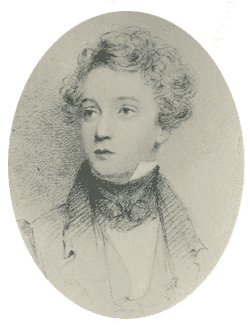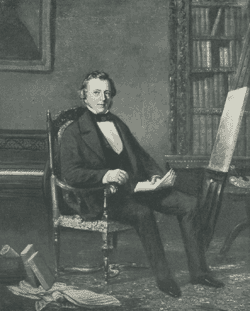Samuel Lover, Miniature Painter
(b. 1797, d. 1868)
Miniature Painter
From A Dictionary of Irish Artists 1913

Samuel Lover, R.H.A. Pencil drawing by Himself; in the National Gallery of Ireland.
Was born in Dublin on 24th February, 1797, the eldest son of S. Lover, a lottery-office keeper and money-changer. At the age of 13 he entered his father's office; but his tastes and disposition were unsuited to a business career. From his childhood he had manifested an extraordinary aptitude for music and drawing; but his father sternly objected to his applying himself to anything but money-making, and the frequent quarrels which arose between them ended by Samuel, at the age of 17, determining to go out into the world and make his own way. For three years he endeavoured to support himself by giving lessons in drawing while yet teaching himself, and in 1817 and 1819 his name appeared as an exhibitor of drawings in the Dublin Society's House in Hawkins Street; and drawings by him were in the water-colour exhibition held in 1823. He confined himself at first to landscape and marine subjects, but the friendship and encouragement of John Comerford led him to apply himself to miniature painting in which he gradually obtained a moderate success.
A portrait of "Lady Morgan" by him was engraved by R. Cooper in 1825, one of "Madame Vestris, as Mrs. Ford," was mezzotinted by S. W. Reynolds in 1826, and a portrait of "Sir William Grace" was engraved in the "Memoirs of the Family of Grace" issued in 1823. Lover began to exhibit in the Royal Hibernian Academy in 1826, and between that year and 1835 he contributed ninety-six landscapes, miniatures and drawings. He was elected an Associate on 22nd May, 1828, and a Member on 6th May, 1829. After he had taken up his residence in London he resigned on 15th March, 1836, and was made an Honorary Member. In 1832 he sent to the Royal Academy a miniature portrait of "Paganini," the violinist, and showed it in the following year in Dublin. This miniature, painted when the Paganini furore was still raging, attracted favourable notice, and encouraged by his success Lover determined to try his fortune in London, and accordingly left Ireland in 1834. In that year he had six works in the Academy, and his miniatures were seen there regularly every year down to 1843 and again from 1851 to 1862.
During the period of his life in Dublin Lover had not confined himself to his work as a miniature painter; but exercised his versatile talents as a musician, a composer, a writer and book-illustrator. In 1818 he gave the first evidence of his powers as a song-writer and reciter by his eulogy on Moore, sung by himself at the banquet given to the poet. He commenced to contribute some of his inimitable tales and legends to the Dublin magazines, including the "Dublin Literary Gazette," where his first effort in literature, a paper on "Ballads and Singers" and his "Story of a Gridiron" appeared; and he became known in Dublin as a teller of humorous stories and a singer. He wrote a number of songs, such as "Rory O'More," "Widow Machree" and "Molly Carew," which, though his voice was poor and feeble, he sung with a drollery and pathos which made him a welcome guest in the best and most brilliant society in Dublin. In 1831 he published "Legends and Stories of Ireland," illustrated by himself, which had an immediate success; and in the same year he did the twelve clever illustrations etched by himself in the "Parson's Horn-Book." He helped to found the "Dublin University Magazine" in 1833 and contributed to it many of his Irish stories. That of "Little Fairly" was illustrated by etchings by himself, and woodcuts after his drawings are in the "Irish Penny Magazine" for the same year. His connection with "The Parson's Horn-Book," caricaturing the established church, lost him a good deal of his business as an artist, which was probably a factor in his resolve to leave Ireland and settle in London. Several of his portraits were engraved; amongst them "W. H. Maxwell" by W. Greatbach in "Bentley's Miscellany," 1840, and a miniature of "Charles Lever" exhibited in London in 1843, engraved by Ryall, as frontispiece to the first edition of "Our Mess" published in Dublin in 1843-44.

Samuel Lover, R.H.A. Picture by James Harwood; in the National Gallery of Ireland.
In London he established himself as a miniature painter and obtained a good connection, and in the literary and social world he became as popular as he had been in Dublin. He commenced novel writing in 1836, with his "Rory O'More," which earned the praises of Maginn, who described him as "at once a musician, a painter, a novelist and a poet" (Blackwood, Vol. XLI). This work was followed in 1842 by his best novel, "Handy Andy," illustrated by himself. A dramatic version of "Rory O'More," with Tyrone Power in the principal part, ran for a hundred nights at the Adelphi Theatre, and was followed by "The White Horse of the Peppers" and other plays. When photography began to lessen the demand for miniature portraits and Lover's sight began to fail, he found himself with a lessened income, and he then betook himself to the interpretation of his own tales and songs and started his "Irish Evenings," a monologue entertainment of songs, recitations and stories, which he produced at the Princess's Concert Rooms. In 1846 he went to America where he gave his entertainment with great success in the United States and Canada. In 1848 he returned to London and gave a new entertainment, "Paddy's Postbag." He began to paint again, and from 1851 to 1862 had a number of landscape drawings in the Academy. His last exhibited work in London was "The Kerry Post on St. Valentine's Day," which he also had in the Hibernian Academy in 1863. His latter days were passed in failing health, and for the last four years of his life he lived in retirement in Jersey, where he died on 6th July, 1868. He was buried in Kensal Green Cemetery on the 15th.
Lover was a man of varied gifts, with a keen wit, a vivacious and brilliant fancy, and a personal charm and sweet temperament which made him a favourite with everyone. "A thoroughly lovable Irishman," he was, says the "Athenaeum" (17th October, 1874), "one of those unfortunately qualified men who do everything well, but fail to be pre-eminent in anything. He was a clever miniature painter, but he could no more have made a fortune by that pursuit than he could as a vocalist." As a miniature painter he was, with his undoubted natural talent, seldom more than mediocre, and his landscapes are forgotten. He was more successful as a writer of Irish stories, both in his inimitable shorter tales and in his novels. His humour sparkles in most of his songs, and it is as a song-writer that Lover ranks highest. Though but slenderly equipped as a musician or a singer, he wedded his ballads to simple and singable airs, and sang them with an expression, a humour and sentiment that went straight to the hearts of his listeners.
Lover married in 1827 a daughter of John Berrel, architect, of Dublin. She died in 1847, and Lover married again in 1852 a Miss Wandby.
In the National Gallery of Ireland are two portraits of him—one a chalk drawing by himself, done in 1828, the other an oil picture by James Harwood, painted in 1856.
"The Life of Samuel Lover, R.H.A., with Selections from his Papers," by Bayle Bernard, was published in 1874.
